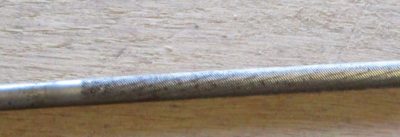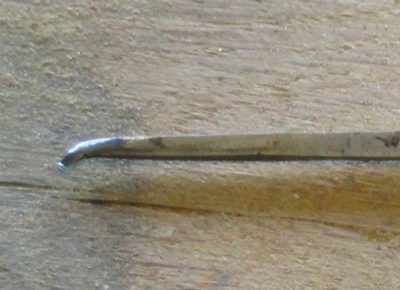The Best Layout Knife I’ve Ever Used…
… and it’s home made and free from the scrap pile!
I was introduced to the layout knife when I went into the pattern shop in 1978 (I was a strictly power tool woodworker prior to that) by shop master John Kuzma, who taught me more about precise work than anyone who has ever crossed my path. Regardless of the scale of the foundry pattern, ranging from a small gear or housing to huge dredge pump components, the standard was always the same — work to the center of a knife cut. Given that the final product in metal was probably going to be machined to a .001″ tolerance this made sense. Rarely/never is this the case for woodworking otherwise.

While marking knives (of an astonishing variety) have been a constant presence in my tool kit over the past 4+ decades I have never encountered a better version of the marking knife than the one John used very day. It was simultaneously no-nonsense and performed exquisitely in every application in the wood shop. Recently I made another of these tools like this. The beauty of this method is that not only do you end up with a superb tool using recycled material, it does not require any de-tempering or re-tempering the material. It’s all cold work.
The starting point was a retired file. I make no secret of my pack-rat tendencies, so I always have old files on hand. If they were a good file, they are good tool steel. John’s knife was built from a 1/4″ square file, this one I just made was from a 3/16″ round chainsaw file. Given my reliance on firewood for heat I have a nearly never ending supply of worn out round files.

The first step of the process is to smooth out the remaining texture of the file teeth using a diamond stone or similar. This leaves a texture but not so much as to be uncomfortable in your hand.

The second step is to put the tang in the vise and give it a bit of a bend. The amount of the bend is slight enough that there is no need for any heat treatment of the metal.
Once the bend is done, sharpen the tip to a knife edge. In my case I use a coarse diamond stone for the shaping followed by a routine regimen of achieving a sharp knife edge. The beauty of this little curved tip is that it enhances the ability to make marks inside or underneath restricted spaces. I have never encountered a better way to transfer the lines of the small dovetails I often make,

On the other end of the file I again used the diamond stone/sharpening stone routine to create a knife bevel and razor sharp tip.
That’s all there is to this tool.
No cost, almost no time (under a half hour) and incomparable performance. Sounds like a near perfect formula to me. As soon as I come across a worn out square file I’ll make one from that, too.


Join the Conversation!